It’s not uncommon for people to feel frightened when they find a spider inside of their home. While many non-threatening species exist in Oklahoma, the state is also home to several dangerous spiders that can cause severe health problems if a bite does occur. Because these threats are always present, it is more important than ever for Oklahomans to be able to identify the spiders that are nesting around their home and when they might be a bigger problem.
Spiders are hunters and will actively seek out and eat other pests or insects. When found near a home, spiders could be providing a beneficial service by keeping other pests in check. Although, once they begin making their way inside, the issue hits a little closer to home and control may be warranted. This is particularly true if a homeowner is finding black widow spiders or brown recluses in areas that they may frequently be spending time.
Emtec Pest Control has been providing spider control services to the metro areas of Tulsa, Oklahoma City and Stillwater since 1979. With over 40 years of experience both identifying and removing spiders from homes and businesses, we are sure to have the perfect solution to combat any species of spider that you may be seeing around your property; however, partnering with us for your spider control is about much more than just a transactional experience and we want to ensure you have the education needed to identify and prevent spiders in the future.
Not all spiders respond to treatments the same way and controlling them is rarely a one-size-fits-all approach. The key to maintaining a spider-free home is to invest in preventative care that helps treat not only for spiders but also the other pests they rely on for food. Below you will find an identification guide that can help you determine what species of spider you are dealing with and an idea of how critical seeking professional help may be. If you are finding any of these spider species in your home or business, the friendly and knowledgeable team at Emtec Pest Control can help remove them.
Many Oklahoma spiders live in residential areas of larger metropolitan areas like Tulsa and Oklahoma City as well as rural areas across much of the state.
From orb weaver spiders to house spiders, the rich diversity of arachnids in the state is impressive and, for some, terrifying. In the following section, we will explain some common spiders throughout the state and provide the information you need to determine if they pose a safety or health hazard.
Often found in gardens, backyards or woodlands, spotted orbweavers can vary in color from a tan color to a mixture of orange and red; however, the diversity among this species doesn’t end there because abdomen markings may also vary between individual spiders. Spotted orbweaver spiders are nocturnal and most active at night. Although it isn’t uncommon to see them during the day hiding in a curled leaf located on the outer edge of the web.
Spotted orbweavers derive their name from their unique orb-shaped webs that can be as large as 2′ in diameter. Because their webs are created from sticky spiral capture silk, they are great collectors of flying insects that are unaware the web has been constructed. If you can watch an orbweaver spider create its nest, you may be in awe as they float a link of silk into the wind to attach to another surface. As a gentle spider, spotted orb weavers are rarely found indoors and pose no safety risk.
Many homeowners across the state of Oklahoma confuse male southern house spiders with the more dangerous brown recluse based simply on their light brown color. Females often have a gray abdomen with dark brown legs and reach up to ¾ of an inch in length once fully matured. While commonly found indoors, this species of spider does not pose any risks and can help limit the populations of other insects; however, control is possible if requested.
Southern house spider webs are often identified by their woolly texture and flat and tangled construction. Outdoors, females and juveniles will spin specialized webs that can be visible on barns, houses, under trees or on bridges. As a timid species of spider, webs are often constructed in areas that will not likely be disturbed by human activity but are likely to net a large amount of other insect travel. For this reason, many people prefer to leave them alone; however, if you think it may be a brown recluse, seek professional assistance for identification.
As one of 2,200+ wolf spider species found worldwide, the Carolina wolf spider is a common home intruder in Oklahoma. Mostly spotted during the summer months, these nocturnal spiders are incredible hunters due to their ability to move quickly and attack their prey even faster. Carolina wolf spiders are primarily brownish-black in color with accents of slate-grey hair covering the body. Although venomous, Carolina wolf spiders rarely bite unless they feel threatened or cornered; however, the bite is rarely dangerous to humans and the pain it delivers resembles a bee or wasp sting.
Unlike other spiders that rely on a web to catch insects for food, the Carolina wolf spider prefers to actively hunt grasshoppers, crickets and other arthropods. Since this species is considered a poor climber they will typically be seen at the ground-level under rocks or holes. When nesting is required, Carolina wolf spiders will typically make burrows into the ground for shelter and come indoors only to seek out food. For this reason, control is rarely needed, and homeowners can generally just remove the spider from the home manually.
Most often identified by the dark brown spot on its cephalothorax that resembles a fiddle, the brown recluse spider is one of the most feared arachnids in the state of Oklahoma. Because their bites deliver necrotic venom that can lead to tissue damage if left untreated, medical treatment is often required for individuals that sustain them; however, brown recluse spiders are very shy and will avoid human contact whenever possible. For this reason, bites generally occur when the spider is disturbed in an article of clothing that was left on the floor or while boxes are being moved from storage.
Brown recluses can often be found inside of storage boxes that have not been disturbed for long periods. Although, they often prefer to nest in wood surfaces that are disconnected from other living things. Inside of a home, this could be in attics, crawlspaces or wall voids. In rare instances, brown recluse spiders may also nest in furniture if it is not used regularly. If brown recluse spiders are found in your home, contact a spider control professional immediately for safe and quick removal.
Although known for their aggressive behavior and even more intimidating name, the rabid wolf spider is rarely a danger to humans. As one of the most common spiders found throughout the United States, this characteristic provides welcome relief to many. While many people associated the term rabid with the potential ability to pass on rabies, the name derives from the spider’s ability to move quickly and erratically whenever it may be needed to avoid predators or catch prey. Rabid wolf spider venom rarely has serious effects and is considered medically insignificant in humans.
Rabid wolf spiders tend to nest in wooded areas or fields because of the food availability and hiding spots these large areas provide. As a nocturnal species, rabid wolf spiders don’t create nests but will burrow into holes and cover them with silk or debris. Like the Carolina wolf spider, the rabid wolf spider prefers to hunt for food by using its speed and agility instead of waiting for insects to become trapped in a created web. While rabid wolf spiders may come indoors to hunt, this isn’t an optimal environment for them, and they won’t stay long.
Well known for its painful bite and potent venom, the black widow spider is found in both rural and urban environments across the state of Oklahoma. Black widow spiders are often identified by the red hourglass shape on their abdomen that offsets the otherwise black color the rest of their body presents. If a bite from a black widow spider occurs, it is important to immediately seek medical treatment to offset the effects that the venom may have both short term and long term. Death from black widow bites is rarely common anymore and patients can recover within 24 hours following treatment.
Black widow spider webs are generally very erratic and have no distinguishable pattern; however, this web design still allows them to catch a variety of insects for food including flies, moths, crickets, grasshoppers and other arthropods. Although most well-known as a predator to other insects, black widows may become the prey for scorpions, centipedes or wasps that are looking for a meal. Most bites from black widow spiders occur when woodpiles or stones they inhabit are disturbed or when spiders are hiding in shoes that have not been worn recently. If found, contact a pest control professional for the safe removal of this potentially dangerous arachnid.
As one of the smallest spiders in Oklahoma, bold jumping spiders are primarily black with a triangular white patch. In some instances, bold jumping spiders may also have white markings on their legs and what appear to be metallic blue or green fang-like chelicerae. A single cluster of bold jumping spider eggs may contain up to 170 individual eggs, making them quick to reproduce during the mid-spring and summer months. Unlikely to bite humans, their small size makes bites particularly insignificant although redness or minor pain may occur.
While bold jumping spiders do not use a web to catch prey, they will often release a silk thread when jumping to ensure they can catch prey if they are unable to pounce on it. Bold jumping spiders can be found on a variety of surfaces both inside and outside and are commonly seen in mailboxes, on patio sets or erratically moving along wall surfaces. Unless found in large numbers, bold jumping spiders rarely require control and pose little risk to humans. During mating periods, female bold jumping spiders will care for eggs until they hatch.
The Yellow Garden spider likes to build their webs adjacent to sunny fields, buildings’ eaves, or tall vegetation. These spiders want to stay hidden from threats, so you will likely not see them roaming around your house. They are black and yellow on their abdomen with white heads. Females are much larger than males, growing to 28mm in body length. The females do not wander; they will spend their entire lives in the same spot.
You can spot a Yellow Garden Spider’s web by its unique patterns. They can be as big as 2 feet in diameter and have a zigzag pattern of silk. The Yellow Garden Spider will eat the inside of its web each night and then rebuild it in the morning. These spiders are not a threat but will bite if you mess with them.
This spider has a compressed body. This allows it to hide under the bark of trees, where they like to live. Their unique body markings give them the ability to camouflage with the trees. Females grow to 13mm in length, while males only grow to about 9.5mm.
The Tan Jumping Spider is a curious spider. They will hang out on fence posts, trees, or any vertical surface and watch you do your business. They are tame enough to even crawl on your hand if you let it. Beware of startling or squeezing it, as it will bite you if threatened.
This tarantula is common in Oklahoma and Texas and is easily identified by its dark brown body and long legs spanning 4 inches. Their shade of brown can vary from one to the other. These tarantulas are primarily found in grasslands in their underground burrows. You can find these as they have a web entrance.
The Oklahoma Brown Tarantula is a docile creature. They will, however, take a defensive stance if they feel threatened. This will look like the tarantula standing on its back legs and showing fangs. This looks much scarier than it should, and chances are it is more scared of you than you of it. This spider will also kick off the barbed hairs from its abdomen in the direction of the threat. This can irritate the eyes and skin. Their venom, though, should not cause you any harm, even if their large fangs could cause large punctures in your skin.
The Green Lynx Female is about twice the size of its male counterpart. They grow about 22mm in length. They are distinguishable by the chevron markings on their backs, each pointing toward the head. Their legs are green to yellow-their color changes in certain seasons. Females can also change their color based on their environment.
These spiders like to live in shrubs, tall grass, or the woods. The female will construct a few 2cm egg sacs containing 25 to 600 eggs. They will hang upside down with their egg sac until it hatches. The female can shoot venom up to a foot as a defense mechanism. They seldom bite humans, but if they do, their venom can cause pain and local swelling.
This jumping spider can take on two completely different appearances, although the same species. The male Dimorphic spider is black with yellow legs or tan with red legs. The females resemble the males, except with short hair covering their bodies. These spiders can jump considerable distances. They will ambush their prey and use a single strand of web to keep them from escaping.
The Flea Jumping spider has the incredible ability to jump more than four times its body length. At 10mm in length, that is more than 40mm. They are intelligent spiders with excellent eyesight, which they use to capture prey up to twice their size. This includes grasshoppers, cockroaches, and crickets.
The Flea Jumping Spider is grey and black with some orange on its sides. They like to live in tall grass or wooded areas. They are not harmful to humans, but they will bite if harassed. Their bite can cause some irritation that usually subsides in a few days.
The Peppered Jumping Spider grows to about 5.5mm in length, with the female slightly larger than the male. The females are grey with a peppered white and black spotted appearance. The males look similar, except with a bronze brown body instead of grey with white markings behind their median eyes, giving them the appearance of a frown. These spiders like to live in tall grass and wooded areas. These spiders are also good at pest control.
These are also called Emerald spiders from their metallic green appearance. The males have black bodies, while the females are brown with orange details. They both have a line of hair in the middle of their back, surrounded by white dots and faint lines. These jumping spiders are more prominent than others, growing to about 10mm in length.
The Golden Jumping spider is an ambush hunter that takes its meals back to its webs to eat and lay eggs. They are usually found in shrubs or on leaves. They will occasionally come inside to get after some insects. They will bite if needed but usually jump away from you and hide.
The Brilliant Jumping Spider is just that in terms of hunting. You will find this thing in old fields, hanging upside down, waiting for its prey to pass by. Once it detects the target, it will drop down on the meal.
This spider is relatively large for its jumping spider family. Females grow to about 4mm, and males grow to only 3.2mm. You can identify them by their red-to-brown or yellow-to-brown color. They will also have a dark marking down their back.
Oklahoma is home to a diverse array of spider species, from harmless garden spiders to reclusive venomous spiders. For any nature enthusiasts living in or visiting the Sooner State, spiders offer an opportunity to observe these remarkable creatures up close While a small number of spider species pose potential medical risks, most are not aggressive towards humans. With some basic knowledge and common sense precautions, observing and photographing spiders can be an engrossing hobby
As an amateur arachnologist living in Oklahoma, I’ve had the chance to discover many of the state’s most notable spiders. Here’s an overview of the top types of spiders that call Oklahoma home:
Jumping Spiders
The jumping spiders of Oklahoma are some of the most endearing to observe. From daring bold jumpers to tiny tan jumpers, these agile spiders rely on stealth and skill to capture prey, not webs.
Some of the jumping spiders you may encounter include
-
Bold jumping spider – One of the most common these stocky black spiders have distinctive white spots and striped legs. The vivid green chelicerae (mouth parts) are hard to miss.
-
Tan jumping spider – As their name suggests, these small light brown jumping spiders have a flattened shape to hide out under bark and stones. Their huge forward-facing eyes have excellent vision.
-
Dimorphic jumping spider – The males and females have radically different appearances, but both can leap surprising distances.
Jumping spiders use their superb eyesight and agility to ambush insect prey. While they will bite if threatened, they pose minimal risk to people.
Orbweaver Spiders
The orbweavers spin large, intricate webs to snare flying insects. Many orbweavers in Oklahoma have striking black and yellow coloring as a warning to birds and other predators. Common examples include:
-
Yellow garden spider – This iconic backyard spider weaves a stunning circular web up to 2 feet across. The contrasting black and yellow pattern makes them easy to identify.
-
Banded garden spider – Similar to the yellow garden spider, these have zIg-zag patterns down their large abdomens. Their webs can be found in bushes and low vegetation.
-
Orchard orbweaver – Possessing beautiful green legs with yellow and black accents, these spiders build their webs in higher branches of trees.
Other orbweavers like the furrow spider and marbled orbweaver hide out during the day and emerge at night to remake their web. Orbweavers are harmless to humans, but may bite if accidentally disturbed.
Recluse and Widow Spiders
Oklahoma is home to two types of spiders with more potent, medically significant venom – the recluse and widow spiders. Caution should be exercised around these venomous spiders:
-
Brown recluse spider – Most common in central and southern areas of the state, these highly venomous light brown spiders have a dark “violin” shape on their cephalothorax. They are non-aggressive, but can inflict serious wounds if trapped against skin.
-
Southern black widow spider – The famous black widow with the signature red hourglass marking can be found throughout Oklahoma. The venom poses more danger to pets and children, but bites should be treated as a medical emergency.
Positive spider identification is critical to take appropriate precautions around recluses and widows. Their habitats and webs offer clues to narrow down the possibilities when spider hunting.
Wolf Spiders and Tarantulas
The huntsman spiders of Oklahoma come in furry and intimidating packages. Ranging from small Tigrosa wolf spiders to heavy-bodied tarantulas, contacts with humans are thankfully infrequent:
-
Carolina wolf spider – Large and hairy, these are among the most commonly seen wolf spiders. They fiercely defend their egg sacs carried by the female.
-
Texas brown tarantula – Oklahoma’s only native tarantula species is this large, docile spider found in burrows in grasslands and forests. Despite their size, they are not dangerous.
-
Rabid wolf spider – Named for their quick movements, these aptly named spiders have contrasting light and dark striping on their legs and abdomen. They prefer to avoid interactions with people.
While startling if encountered, the wolf spiders and tarantulas of Oklahoma are far less threatening than their size and appearance suggest. They help control pest populations as formidable insect predators.
Cobweb Spiders
Cobweb spiders use tangled, messy webs to capture prey rather than elegant orb-style webs. Their small size also means they often go unnoticed by homeowners. Cobweb spider examples in Oklahoma include:
-
Triangulate cobweb spider – This aptly named spider has a triangular pattern on its bulbous abdomen. They build webs in dusty corners of homes to catch prey.
-
Common house spider – As the name suggests, these are frequently found indoors in dark corners and window frames. Their venom poses minimal hazards to humans.
-
Black cobweb spider – One of the more striking cobweb spiders, these have black legs and prominent white markings on a dark abdomen. They prefer building webs in garages and other structures.
The abundance of insects for prey allows cobweb spiders to thrive indoors and around human structures. While startling to come across, their small size means bites are very uncommon.
Observing Spiders Safely
With over 33 recorded spider species calling Oklahoma home, there are ample opportunities to observe these captivating creatures throughout the state. Species like jumping spiders, orbweavers and cobweb spiders can be found nearly anywhere by looking carefully at windows, gardens, bushes and trees.
Around docile spiders, simply admiring them from a respectful distance is recommended. For handling, mature bold jumping spiders often tolerate gentle interactions. Always exercise caution around venomous spiders like widows and recluses, and teach children not to touch unknown spiders.
With proper identification and common sense precautions, Oklahoma’s diverse spider population offers a microcosm of nature to discover in your own backyard. From tiny jumping spiders to imposing tarantulas, mapping out your neighborhood spiders this summer is guaranteed to be a fascinating adventure!

Hammer Jawed Jumping Spider
The Hammer Jawed Jumping Spider is like other jumping spiders. They are excellent jumpers and use their skills to ambush prey or escape predators. They have a yellow-to-dark-brown appearance and a large, squared head. They will bite if provoked but usually are harmless.


American Nursery Web Spider
The Nursery Web Spider gets its name from the care the females give their eggs and young. They will protect their egg sacs at all costs, biting you if you get too close. They like to live near water, in tall grass, or in wooded areas. They are wandering hunters, so they do not use webs to catch their prey.
You can spot these spiders by their long bodies and raised heads. They are brown with a dark band and two rows of spots on their back. These spiders look similar to the wolf spider but are skinnier and more protracted.
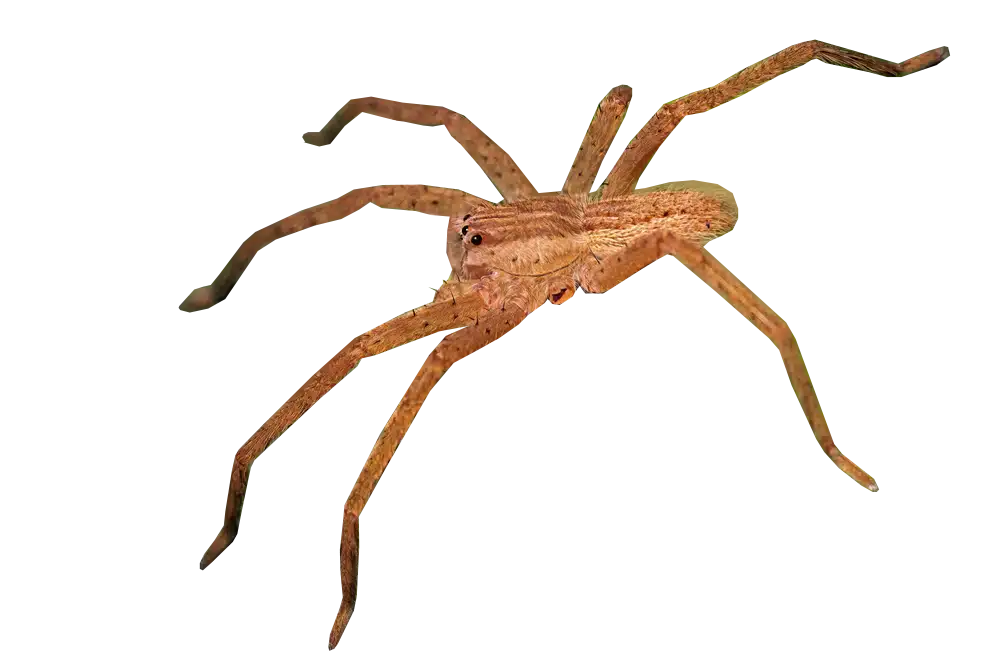
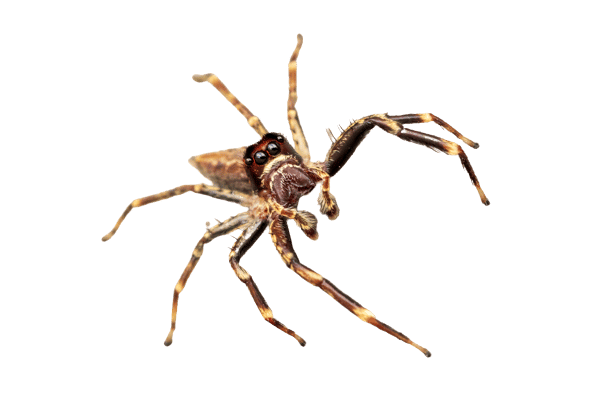
The male and female look similar but have subtle differences. The males grow to about 6.7mm in body length. They have a dark bronze head with a lighter bronze body. They also have white banding on their head and body. The female grows larger at 8mm, with a light bronze head and darker body. They have less prominent banding and spots.
These spiders are ambush hunters, leaving a single strand of thread after they hunt to help capture their prey. You can find these spiders in many different areas around your home or the wild. They are also curious and jump on your hand if you let it. They will only bite if they feel threatened.

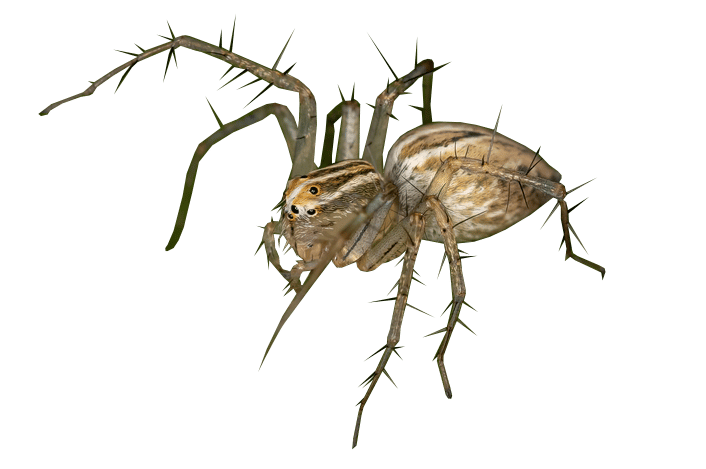
The Striped Lynx Spider has prominent dark hairs on its legs. They are green to brown with stripes on their head and body. They also display a diamond shape on their back. They can grow to 6mm, with the females slightly larger than the males.
They are ambush hunters. They create a web where they bring their meals, hide from other threats, or lay their eggs.


The Putnam Jumping Spider is an active ambush hunter that uses its excellent eyesight to scan for its meals. It can jump four times its body length when hunting. It will shoot a single strand of web to subdue its meal. It bites the prey to paralyze it and drags it back to its web.
These guys are hairy, with tufts of hair above their eyes and on their sides. They can be found in many locations and sometimes come inside. They are not dangerous, though, so do not fear them.

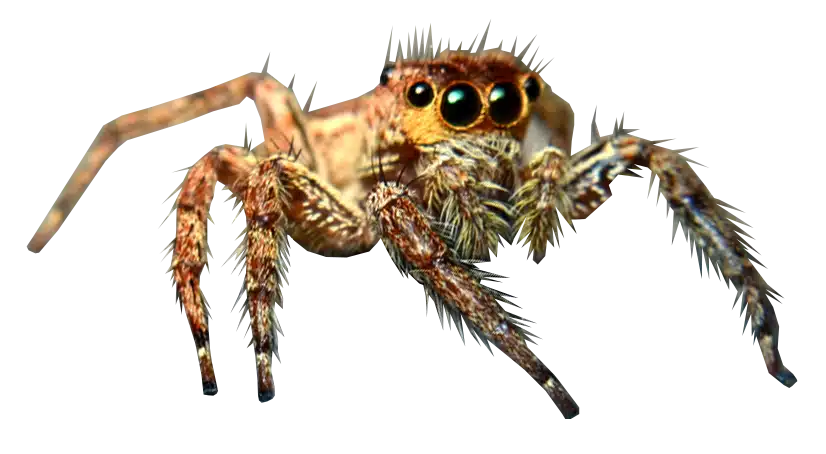
The Common Hentz Spider is notable for its long, large front legs, which are dark red. The rest of their legs are yellow. Their head and body are reddish browns with white banding around the sides. Their eyes are large, and they have orange hair surrounding them. Their long legs help them ambush their prey, hold them down, and inject their venom. They only grow to 7mm (female) and 5.3mm (male).
They can be found in piles of leaves in your yard and sometimes make their way into your home. They will bite if provoked, but the bite will be slightly painful. The pain should only last a short while. The good news is they will likely jump away if you get too close.

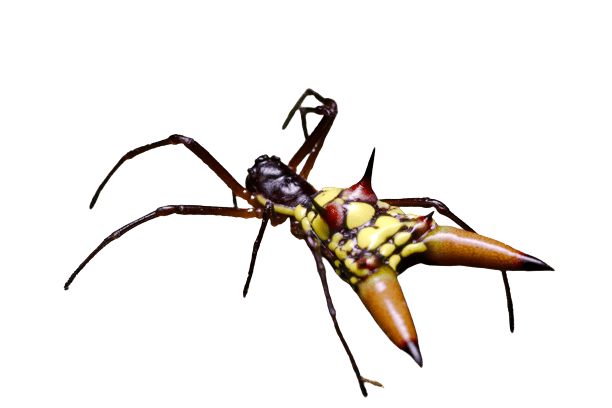
The Spined Micrathena Spider belongs to the Ordweaver family. They will create large, tightly coiled webs that can get as large as 2 feet in diameter. They are active during the day, but you might only see them at the end of summer and the start of fall.
These guys grow to lengths of 10.8mm, with the females more prominent than the males. The females have a larger white and black abdomen with spines around it. The males have smaller abdomens with fewer spines and are also slightly lighter in color. They are harmless to humans.

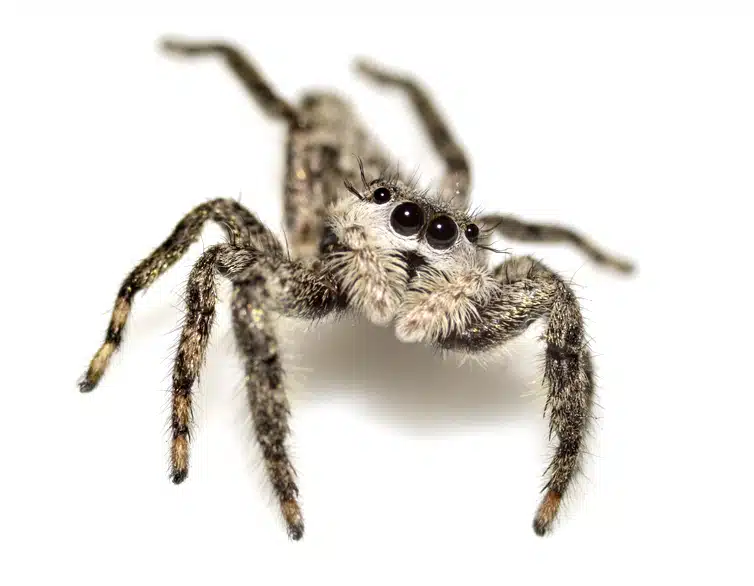
The Grayish Jumping Spider is just like other jumping spiders. They are excellent jumpers and ambush their prey. They will create webs only as a haven or a place to eat their meals. They have a gray appearance with a reddish back.


Deadly Spiders of Oklahoma (10/25/14)
FAQ
What is the most common house spider in Oklahoma?
Then there is the house spider. This spider species gets its name from the fact that it is probably the most common species found inside homes. It is the species Achaearanea tepidariorum. Here are a few things every Oklahoma City resident should know about them.
Are there any venomous spiders in Oklahoma?
In Oklahoma, only two spiders, the brown recluse and black widow, are considered dangerous to people. However, tarantulas, jumping spiders, wolf spiders, garden spiders, and numerous other species found in the State are frequently mistaken for venomous spiders.
What is the biggest spider in Oklahoma?
The Oklahoma brown tarantula can weigh from 1 to 3 ounces when fully grown, and they can grow a leg span of 4 to 5 inches.
What spiders are mistaken for brown recluse spiders?
-
While wolf spiders can be brown and have a similar body shape to brown recluses, they lack the distinctive violin-shaped mark on their cephalothorax (the area between the head and abdomen) and often have stripes or bands on their legs.
-
These spiders, also known as “daddy long legs,” are often mistaken for brown recluses due to their long legs, but they have a different body shape and lack the violin-shaped marking.
-
Funnel weavers are often mistaken for brown recluses, but they have eight eyes (brown recluses have six), and their webs are funnel-shaped.
-
Woodlouse spiders, also known as “woodlouse hunters,” are sometimes mistaken for brown recluses, but they have long, sickle-like jaws for feeding on woodlice.
-
Hobo spiders are sometimes mistaken for brown recluses due to their brown coloring, but they have a chevron pattern on their abdomens.
-
Yellow sac spiders are often mistaken for brown recluses, but they lack the violin-shaped pattern and have a dull, dark stripe lengthwise down their abdomen.
-
While orb weavers can be brown, they lack the violin-shaped marking and have a distinctive orb-shaped web.
-
These spiders are generally larger and more visible around homes, while brown recluses are smaller, more secretive, and have a distinctive violin-shaped marking.
